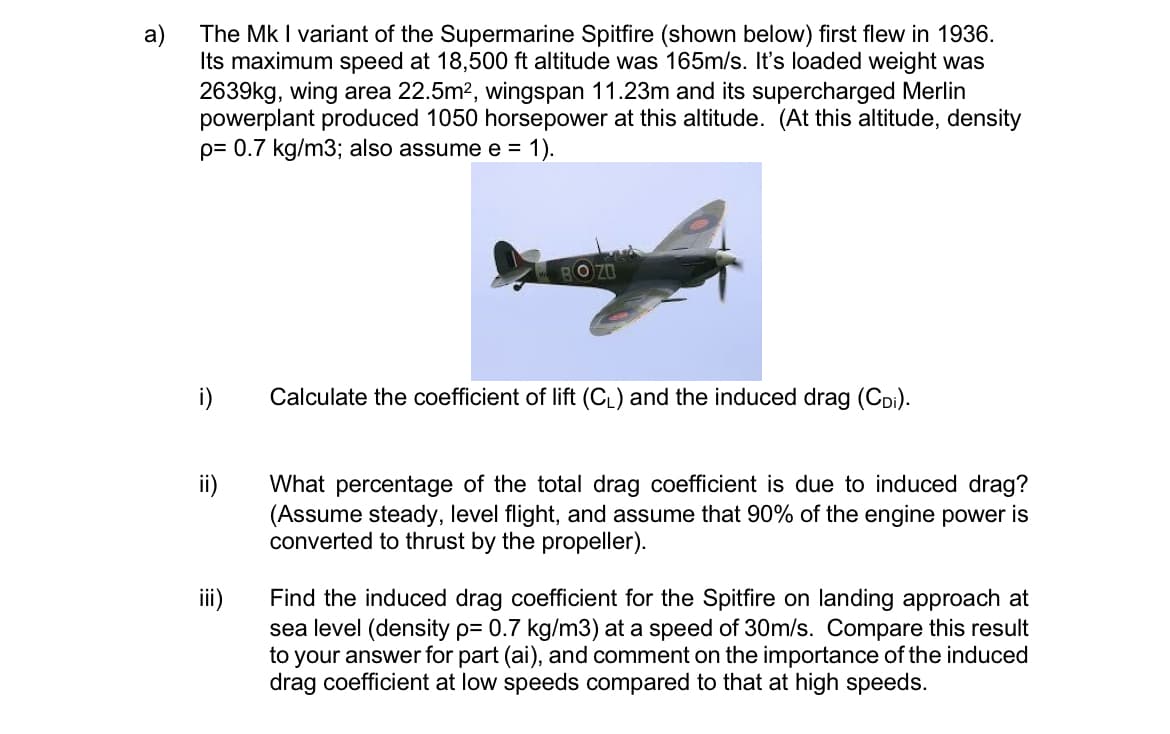The Mk I variant of the Supermarine Spitfire (shown below) first flew in 1936. Its maximum speed at 18,500 ft altitude was 165m/s. It's loaded weight was 2639kg, wing area 22.5m2, wingspan 11.23m and its supercharged Merlin powerplant produced 1050 horsepower at this altitude. (At this altitude, density p= 0.7 kg/m3; also assume e = 1). а) %3D i) Calculate the coefficient of lift (CL) and the induced drag (CDi). ii) What percentage of the total drag coefficient is due to induced drag? (Assume steady, level flight, and assume that 90% of the engine power is converted to thrust by the propeller). iii) Find the induced drag coefficient for the Spitfire on landing approach at sea level (density p= 0.7 kg/m3) at a speed of 30m/s. Compare this result to your answer for part (ai), and comment on the importance of the induced drag coefficient at low speeds compared to that at high speeds.
The Mk I variant of the Supermarine Spitfire (shown below) first flew in 1936. Its maximum speed at 18,500 ft altitude was 165m/s. It's loaded weight was 2639kg, wing area 22.5m2, wingspan 11.23m and its supercharged Merlin powerplant produced 1050 horsepower at this altitude. (At this altitude, density p= 0.7 kg/m3; also assume e = 1). а) %3D i) Calculate the coefficient of lift (CL) and the induced drag (CDi). ii) What percentage of the total drag coefficient is due to induced drag? (Assume steady, level flight, and assume that 90% of the engine power is converted to thrust by the propeller). iii) Find the induced drag coefficient for the Spitfire on landing approach at sea level (density p= 0.7 kg/m3) at a speed of 30m/s. Compare this result to your answer for part (ai), and comment on the importance of the induced drag coefficient at low speeds compared to that at high speeds.
University Physics Volume 1
18th Edition
ISBN:9781938168277
Author:William Moebs, Samuel J. Ling, Jeff Sanny
Publisher:William Moebs, Samuel J. Ling, Jeff Sanny
Chapter8: Potential Energy And Conservation Of Energy
Section: Chapter Questions
Problem 8.4CYU: Check Your Understanding Suppose the mass in Equation 8.6 is doubled while keeping the all other...
Related questions
Topic Video
Question
Please answer these questions on aerodynamics

Transcribed Image Text:The Mk I variant of the Supermarine Spitfire (shown below) first flew in 1936.
Its maximum speed at 18,500 ft altitude was 165m/s. It's loaded weight was
2639kg, wing area 22.5m2, wingspan 11.23m and its supercharged Merlin
powerplant produced 1050 horsepower at this altitude. (At this altitude, density
p= 0.7 kg/m3; also assume e =
a)
1).
O Z0
i)
Calculate the coefficient of lift (CL) and the induced drag (CDi).
What percentage of the total drag coefficient is due to induced drag?
(Assume steady, level flight, and assume that 90% of the engine power is
converted to thrust by the propeller).
iii)
Find the induced drag coefficient for the Spitfire on landing approach at
sea level (density p= 0.7 kg/m3) at a speed of 30m/s. Compare this result
to your answer for part (ai), and comment on the importance of the induced
drag coefficient at low speeds compared to that at high speeds.
Expert Solution
This question has been solved!
Explore an expertly crafted, step-by-step solution for a thorough understanding of key concepts.
Step by step
Solved in 4 steps with 4 images

Knowledge Booster
Learn more about
Need a deep-dive on the concept behind this application? Look no further. Learn more about this topic, physics and related others by exploring similar questions and additional content below.Recommended textbooks for you

University Physics Volume 1
Physics
ISBN:
9781938168277
Author:
William Moebs, Samuel J. Ling, Jeff Sanny
Publisher:
OpenStax - Rice University

University Physics Volume 1
Physics
ISBN:
9781938168277
Author:
William Moebs, Samuel J. Ling, Jeff Sanny
Publisher:
OpenStax - Rice University